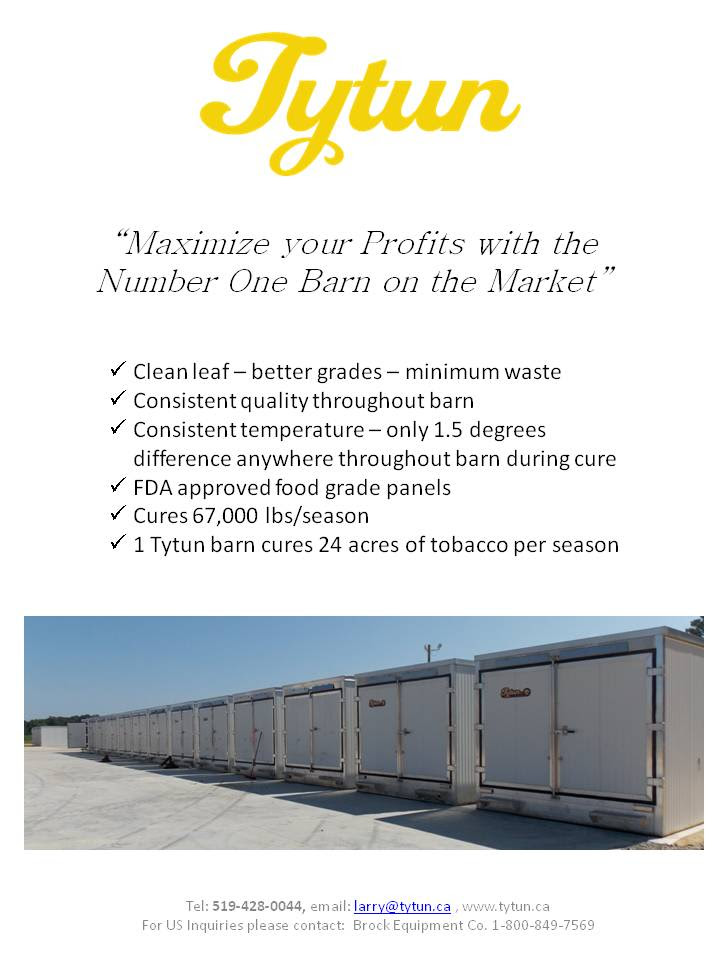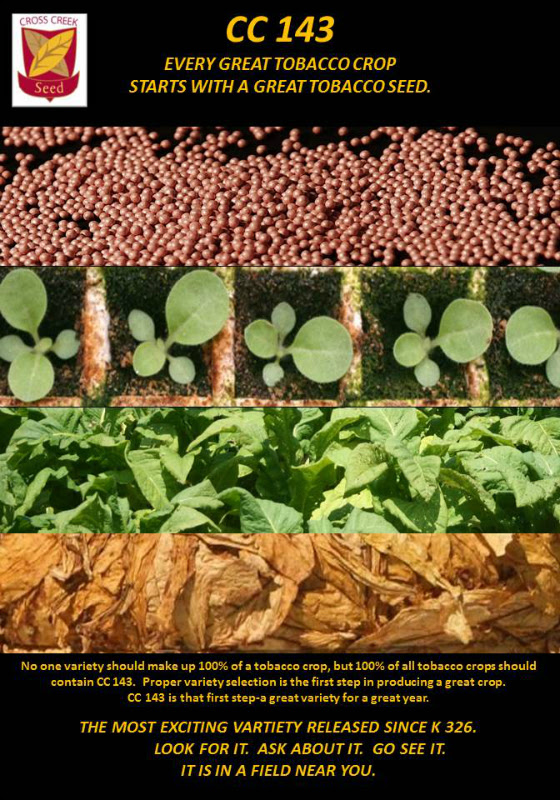Bales of flue-cured on the floor of Old Belt Sales warehouse in Rural Hall, N.C., right after the last sale of the season on November 22.
Glad its all over: The flue-cured market came to what was for all practical purposes
the end of its season on November 22 when the Old Belt Warehouse in Rural Hall,
N.C., held its last 2016 auction. Much of the offerings at that sale and the one
held the week before was sunbaked and drew a low price. But until that late-season
slide, the price had held up pretty well, says warehouse manager Dennis White.
"We averaged somewhere around $1.60 a pound, which was comparable to contract prices."
he says. He estimated the practical top at $1.80 a pound. His farmers seemed satisfied
at the auction performance as a whole.
The Piedmont got off to a terrible start when spring rains created what was in effect
an early crop and a late crop...and the early crop got much the better growing conditions.
"We wound up with 62 days of 95 degree plus temperatures, and that weighed very
heavily on the later planted tobacco," says White. "The quality may have been as
bad as 1977 or maybe worse."
Getting updated on good agricultural practices: GAP Connections (GAPC) farmer meetings
begin in early January. Some dates have already been set (see below). "The meetings
will be conducted in cooperation with the state Extension programs, as local meetings
or as part of other regular events such as trade shows, association meetings and
company meetings," says Paul Denton of the GAP staff. "Training will cover crop
management, environmental management and labor management--specific to the needs
of growers in the area--with a short update on GAPC programs and activities."
Does "GAP Certified" mean anything? The phrase GAP Certified has appeared from time
to time since the training sessions first began, including advertising ap-pearing
in this publication. Auction warehouses used the phrase the first year to indicate
their full cooperation and especially their willingness to arrange GAP training
for growers who didn't have access to meetings, so that they can obtain certification.
Editor's Note: As far as I know, this never happened. That phrase should be eliminated. As Denton tells TFN, "There currently is no label
of 'GAP Certified' for farms following GAP standards. Even for those growers who
go through a third-party assessment, there is no score given and no designation
of passing or failing by GAPC." Contracting companies can require grower participation
in the program and affirm that their growers attend training and complete an assessment
if chosen. "But they cannot accurately say that their growers are 'GAP certified'
through GAPC because there is no true certification system in place," said Denton.
A followup report on international tobacco control: Despite attempts to bring their
concerns before the current negotiations on the Framework Convention for Tobacco
Control (FCTC) in India last month (see the November II 2016 issue of TFN), leaders
of the International Tobacco Growers Association (ITGA) say they have had little
success. "In spite of our efforts to open a line of communication with the FCTC
Secretariat and our willingness to cooperate and share our members' vast experience
ITGA has been denied participation or even an audience with the delegates or the
FCTC Secretariat," says Daniel Green, c.e.o. of Burley Stabilization Corporation
in Springfield, Tn., and new president of ITGA. "We will keep you informed on this
issue."
Outlook bleak for burley and dark: GAPC's Denton says his sources in Kentucky are
"really" pessimistic about the yield and quality of this year's offerings. "One
dark representative thinks the dark-fired crop could be off by half, and the burley
growers I've talked to report yields in the 1,500-pound range," he says. "There
is some concern about high color due to dry curing conditions." But reports from
Ohio and Pennsylvania are much more optimistic, he says.
Burley supply and demand balance improved greatly over the past year, says Will
Snell, Kentucky Extension economist,. That lead to "modest changes in U.S. burley
contract volume for 2016, following significant reductions in 2015," Snell says. "Smaller crops in South America, Africa and the United States. coupled with a surprising
[though] modest increase in U.S. cigarette production in 2015 helped offset the adverse impacts of a strengthening dollar on U.S. burley international competitiveness."
A quick reduction in flue-cured inventories: Large global inventories of flue-cured
were problematic going into 2015 but had largely disappeared by 2016, says Blake
Brown, N.C. Extension economist. The quick reduction was mostly due to excessive
rain in Brazil in 2016 that led to the smallest flue-cured crop in over a decade, at just over one billion pounds, according to Universal Leaf. That was down from
1.26 billion pounds in 2015. Zimbabwe also experienced a smaller 2016 flue-cured crop because of severe drought during autumn 2015. Its production for 2016 was estimated
at 438 million pounds, down from 477 million pounds in 2015, according to the Zimbabwe
Tobacco Association.
DATES TO REMEMBER
* December 1. N.C. Tobacco Day 2016. Johnston County Extension Center, 2736 N.C.
Hwy. 210, Smithfield, N.C. Meeting starts at 8:15 a.m. and ends with lunch.
* January 11-12. S.C. Agribiz and Farm Expo. Florence (S.C.) Civic Center.
* February 1-3. Southern Farm Show. N.C. State Fairgrounds, Raleigh, N.C.
* February 3. Annual Meeting, Tobacco Growers Association of N.C., Holshouser Bldg.,
N.C. State Fairgrounds. 10 a.m. to 1 p.m., ending with lunch (during Southern Farm
Show).
GAP RECERTIFICATION MEETINGS
North Carolina (Flue-Cured)
* January 4, 9 a.m. Martin County Farmers Market, 4001 West Main St., Williamston
NC. Lunch will be provided. DOL and WPS presentations will be at beginning of meeting.
Need 75 labor posters. Contact Al Cochran at al_cochran@ncsu.edu at 252-789-4370.
* January 6, 9 a.m. The Farmer's Market, 1006 Peachtree St., Rocky Mount NC. Contact
Art Bradley at art_bradley@ncsu.edu at-252-614-7815.
* January 10, 9 a.m. Johnston County Extension Center 2736 NC 210 Highway, Smithfield
NC. Contact Bryant Spivey at bryant_spivey@ncsu.edu 919-989-5380.
* January 11, 9 a.m. Wilson County Ag Center, 1806 Goldsboro St. SW, Wilson NC 27893.
Contact Norman Harrell at norman_harrell@ncsu.edu or 252-237-0111.
* January 12, 8:30 a.m. Forsyth County Extension Center, 1450 Fairchild Rd., Winston
Salem NC. Lunch provided. Contact Tim Hambrick or tim_hambrick@ncsu.edu or 336-703-2857.
* January 13, 8:30 a.m. Granville County Expo Center, 4185 US Highway 15, South
Oxford NC. Contact Gary Cross at gwcross@ncsu.edu or 919-603-1350.
* January 18, 9 a.m. Wayne County Extension Center, 208 Chestnut St., Goldsboro
NC. Contact Tyler Whaley at tyler_whaley@ncsu.edu or 919-731-1527.
* January 19, 9 a.m. Lenoir County Shrine Club, 1558 Hwy 70, East Kinston NC. Registration
begins at 8 a.m. Contract Mike Carroll or mike_carroll@ncsu.edu - 252-633-1477.
* January 20, 9 a.m. McSwain Extension Center, 2420 Tramway Rd., Sanford NC. Contact
Zack Taylor at zrtaylor@ncsu.edu. or919-775-5624 3455.
* January 23, 8 a.m. Caswell County Civic Center, 536 Main St., East Yanceyville
NC. Registration opens at 8 a.m. Meeting will start at 9 a.m.. Lunch will be served.
Contact Joey E. Knight, III at joey_knight@ncsu.edu or 336-694-4158.
* January 24, 9 a.m. Harnett County Government Complex Commons Area 309 W. Cornelius
Harnett Blvd Lillington NC 27546 Registration begins at 8 a.m. Contact Brian Parrish
at brian_parrish@ncsu.edu or 910-8937530.
* January 25, 9 a.m. Sampson County Ag Expo Center 414 Warsaw Rd. Clinton NC. Contact
Della King at della_king@ncsu.edu or 910-592-7161.
* February 3, 1:30 p.m. Holshouser Bld., NC State Fair Grounds, Raleigh NC (in conjunction
with TGANC Annual Meeting during Southern Farm Show). Lunch will be provided. Contact
Matthew Vann at matthew_vann@ncsu.edu or 919-513-0904.
Virginia (Flue-cured)
* January 17, 9 a.m. Southern Piedmont Center, 2375 Darvills Rd., Blackstone VA
Registration at 8:30 a.m. Contact Lindy Tucker at tucker07@vt.edu or 434-696-5526.
* January 18, 4 p.m. Meherrin River Hunt Club, 435 Dry Creek Rd., South Hill VA.
Registration at 3:30 p.m. Contact Taylor Clarke at clarke@vt.edu or 434-738-6191.
* January 19, 4 p.m. Olde Dominion Ag Complex 19783 U. S. Highway 29, South Chatham
VA. Registration at 3:30 p.m. Contact Stephen Barts sbarts@vt.edu 434-432-7770
3459
* January 25, 10 a.m. Scottsburg Volunteer Fire Dept., 3050 Scottsburg Rd., Scottsburg
VA. Registration at 9:30 a.m. Contact Rebecca Slabach at cbrown04@ vt.edu 434-476-2147.
* February 15, 10 a.m. Midway Baptist Ch., Midway Rd., Phenix VA. Registration at
9:30 a.m. Contact Bob Jones at rojones2@vt.edu or 434-542-5884.
































